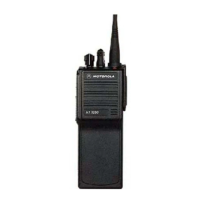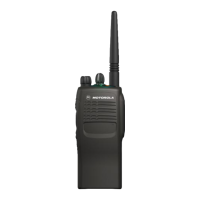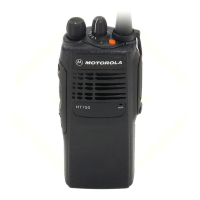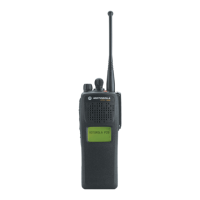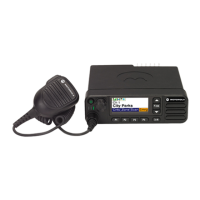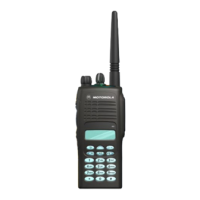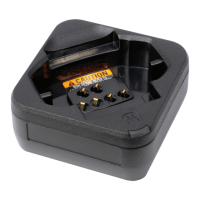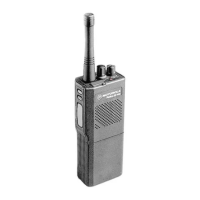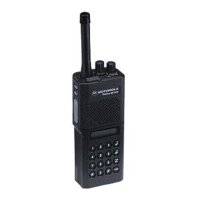23
A. Introduction
This section of the manual describes preventive
maintenance, safe handling of CMOS devices, and
repair procedures and techniques. Each of these topics
provides information vital to the successful operation
and maintenance of your radio.
B. Preventive Maintenance
The HT 1000, MT 2000, MTS 2000, and MTX series
radios do not require a scheduled preventive mainte-
nance program; however, periodic visual inspection and
cleaning is recommended.
1. Inspection
Check that the external surfaces of the radio are
clean, and that all external controls and switches
are functional. A detailed inspection of the interior
electronic circuitry is not needed or desired.
2. Cleaning
The following procedures describe the recommend-
ed cleaning agents and the methods to be used
when cleaning the external and internal surfaces of
the radio. External surfaces include the front cover,
chassis (rear cover), and battery case. These sur-
faces should be cleaned whenever a periodic visual
inspection reveals the presence of smudges,
grease, and/or grime. Internal surfaces should be
cleaned only when the radio is disassembled for
servicing or repair.
The only recommended agent for cleaning the
external radio surfaces is a 0.5% solution of a mild
dishwashing detergent, such as JOY
®
, in water. The
only factory recommended liquid for cleaning the
printed circuit boards and their components is iso-
propyl alcohol (70% by volume).
a. Cleaning External Plastic Surfaces
(The detergent-water solution should be applied
sparingly with a stiff, non-metallic, short-bristled
brush to work all loose dirt away from the radio.
A soft, absorbent, lintless cloth or tissue should
be used to remove the solution and dry the
radio. Make sure that no water remains
entrapped near the connectors, cracks, or
crevices.
b. Cleaning Circuit Boards and Components
Isopropyl alcohol may be applied with a stiff,
non-metallic, short-bristled brush to dislodge
embedded or caked materials located in hard-
to-reach areas. The brush stroke should direct
the dislodged material out and away from the
inside of the radio.
Alcohol is a high-wetting liquid and can carry
contamination into unwanted places if an
excessive quantity is used. Make sure that con-
trols or tunable components are not soaked
with the liquid. Do not use high-pressure air to
hasten the drying process, since this could
cause the liquid to puddle and collect in unwant-
ed places.
Upon completion of the cleaning process, use a
soft, absorbent, lintless cloth to dry the area. Do
not brush or apply any isopropyl alcohol to the
frame, front cover, or back cover.
NOTE
Always use a fresh supply of alcohol and a
clean container to prevent contamination by dis-
solved material (from previous usage).
C. Safe Handling of CMOS Devices
Complementary metal-oxide semiconductor
(CMOS) devices are used in this family of radios. While
the benefits of CMOS are many, their characteristics
make them susceptible to damage by electrostatic or
high voltage charges. Damage can be latent, resulting in
failures occurring weeks or months later. Therefore, you
must take special precautions to prevent device damage
during disassembly, troubleshooting, and repair. Han-
dling precautions are mandatory for CMOS circuits, and
are especially important in low humidity conditions. DO
NOT attempt to disassemble the radio without first
referring to the CMOS CAUTION paragraph in the Dis-
assembly and Reassembly section of the manual.
D. Repair Procedures and Techniques
Refer to the Disassembly and Reassembly section
of the manual for pertinent information prior to replacing
and substituting parts.
1. General
a. Parts Replacement and Substitution
Special care should be taken to be as certain
as possible that a suspected component is
actually the one at fault. This special care will
eliminate unnecessary unsoldering and removal
of parts, which could damage or weaken other
components or the printed circuit board itself.
When damaged parts are replaced, identical
parts should be used. If the identical replace-
ment component is not locally available, check
the parts list for the proper Motorola part num-
ber and order the component from the nearest
Motorola Communications Parts office listed in
the "Replacement Parts Ordering" section of
this manual.
SECTION VII. MAINTENANCE
The effects of certain chemicals and their vapors
can have harmful results on certain plastics.
Aerosol sprays, tuner cleaners, and other chemi-
cals should be avoided.
!
CAUTION
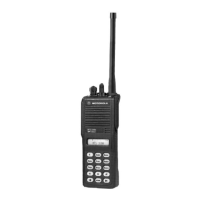
